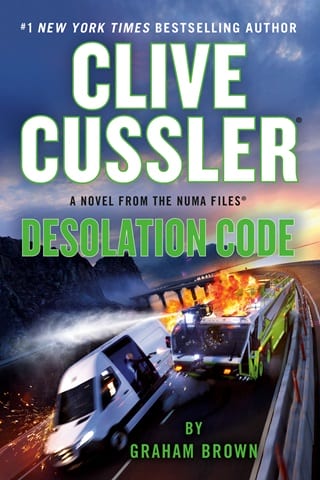Chapter 37
NUMA Headquarters, Washington, D.C.
Rudi Gunn stared at a map. Not a computer-generated image on a screen, but an old-fashioned map of the world mounted on the wall in his office. His eyes were focused on the Indian Ocean while his mind considered the possibilities.
Somewhere, on one of the hundreds of islands in that ocean, a madman was performing experiments on humans he’d grown in a laboratory. But who and which island still escaped him.
He needed a complex analysis performed, one that would take humans days if not weeks, but he’d hesitated on assigning it to a computer team.
Leaving his office, he went up to the eleventh floor, where he met with Hiram Yaeger to ask a few tough questions and discuss Kurt’s assertion that they’d been hacked.
Yaeger did not agree. “After what happened with Kurt’s phone I can’t promise the communications network is secure, but I have no reason to believe the servers have been affected.”
Rudi had expected nothing less. “If someone could hack the communications network, what’s to prevent them from hacking our main database?”
“For one thing, they’re different systems,” Yaeger insisted. “Connected, but not dependent on each other. For another, the main database is protected by state-of-the-art cybersecurity protocols.”
Rudi continued to press for answers. “Have you tested the security protocols?”
Yaeger nodded. “Max and I have probed for any weakness in the system or undefended points of entry. We haven’t found any flaw in the firewall or any evidence of an attack. The simulations we’ve run suggest that overcoming our security would require a massive amount of computing power.”
“How much power are we talking about?”
“More than we have here,” Yaeger said. “More than they have over at Langley or at the NSA. Imagine all the computers at the Department of Defense, the CIA, and the NSA linked together in one hyper-fast network and being controlled by a system as advanced as Max. That’s what it would take. And it would leave a scar. Which we haven’t found.”
Rudi understood what Yaeger was saying—and he trusted him implicitly—but the facts Kurt had presented were not to be discounted so easily. He wondered if they were becoming too reliant on the computers. They needed Max to determine if the rest of the network had been hacked, but unless someone personally went through a billion lines of code, how could they know if Max was speaking the truth?
“Could Max be wrong?” Rudi asked. “For that matter, could Max have been hacked and then prompted to tell you there was no sign of a breach?”
Yaeger sighed. He understood the problem. “Max can obviously be wrong, but only if the data is corrupt, and it’s not. As far as Max being hacked…” He shook his head. “Even if someone with all the capabilities and computing power I just described managed to break into the main network, Max would remain secure.”
“How?” Rudi asked. “What makes Max so impervious to any outside influence?”
Yaeger explained. “NUMA’s main network is built from commercial servers running advanced but well-known operating languages: C++, Java, Python, and several others. But I built Max from the ground up. I designed her network and created a unique programming language for her that I’ve never shared publicly or privately. To penetrate her system, someone would have to learn her language, decipher the unique way it’s coded, and then start probing for a weakness in a completely unfamiliar architecture, which would almost certainly lead to instant detection.”
Rudi narrowed his gaze. He needed more convincing.
Yaeger offered a couple of metaphors to sway him. “Imagine trying to decipher hieroglyphics without the Rosetta stone. All you’re going to see are pictures with no meaning. It’s the difference between overhearing a conversation in a language you’re familiar with and overhearing two aliens from another galaxy talking in their native tongue. In the second case you’re going to hear clicks and grunts and noises—I presume—but you’re not going to get any information out of it. You’ll have no way of knowing what any of it meant.”
“But people do learn other languages,” Rudi countered.
“Only from other people. And only if they’re taught. And I’ve taught no one in the outside world anything about Max and her programming.”
Rudi was convinced. At least as convinced as a layperson could be. “Okay,” he said. “In that case, we keep Max online, but I need you to disconnect her from our servers, from our comm system, and from the rest of the internet. No cables, no wires, no Wi-Fi. No tin can with a string.”
“You want me to put an air gap between Max and the outside world,” Yaeger said, using the term of art for a computer that was set up apart from the network.
“That way we can still consult with her,” Rudi said. “But we counter the risk that someone is listening in.”
Yaeger exhaled slowly. “Fine,” he said. “It’s overkill, in my opinion, but I understand why you want it that way.” He tilted his head toward the ceiling. “Max?”
The computer—which was always listening—responded instantly. “Very well,” she said in her slightly electronic but otherwise female voice. “I’ll cut the links. I could use a break from the hustle and bustle anyway. Disconnecting…now.”
Screens around them that had been filled with complex graphics and other forms of data presentation now showed the progress of the decoupling process. Spiky lines on various graphs oscillated, dropped sharply toward the bottom of the screen, and then flatlined. Displays showing input and output speeds ramped up for a brief moment and then spun down to zero. On one wall a line of LED indicators went from green to yellow and then finally to a deep blue, which indicated a standby mode.
“I’m now disengaged from the outside world,” Max said. “Consider me on vacation.”
“Not so fast,” Rudi said. “We still need you to analyze something for us. But taking a page out of Kurt’s book, we’re going to do this the old-fashioned way.” He turned to Hiram. “You and I will get the data we need on hard copies and then punch it in by hand. When Max comes up with an answer, I’ll find a way to get it over to Kurt without using our communications network.”
“Are you sure we have to do that?” Yaeger asked. “Max has a vast internal database. Including satellite scans and historical oceanic data.”
“Unfortunately, I don’t store mundane records such as weather reports or wave heights or anything of that nature,” Max said. “I prefer to follow the example of Albert Einstein, who insisted he didn’t memorize anything that could be easily looked up by his assistants.”
“That would be us at this point,” Yaeger suggested, in case Rudi somehow missed the jibe.
Rudi had started the meeting concerned that they were becoming too dependent on machines. Now they were working for one. He wasn’t sure things were moving in the right direction. “Let’s get to it.”
Working by hand, and scanning printed records, it took an hour to input the weather reports, wind advisories, and information on the currents. As the effort dragged on, Yaeger recalled one of the original reasons he’d gotten into computer design in the first place: as a way to delegate tedious and mundane tasks like collating data. After one last wave-propagation chart was placed on a scanner and added to the data file, he turned to Rudi. “Anything else?”
“That’s it. That’s all the information we have.”
Yaeger was glad to hear that. “All right, Max, your turn to shine. Put this all together and give us a report on Kurt’s drifting beacon.”
After a minute of studying the data, Max was able to create an ad hoc weather model. Ten seconds later she’d determined the most likely drift pattern of the small boat as it wallowed in the current before its occupants were picked up by the freighter. Kurt had mentioned the presence of a rudimentary sail, but no one knew how often it was used or what its efficiency was. Max modeled a range of possibilities and quickly determined the most likely starting point for the small boat. It had taken an hour to enter the data and less than two minutes for Max to do the rest.
“The probable origination point for the small boat’s journey is an island in the Seychelles known as ?le de l’Est,” Max announced. “East Island. Now mostly referred to as l’Est. It’s one of only two partially volcanic islands in the Seychelles chain.”
Scanning her own proprietary records, Max pulled up a recent satellite photo and placed it on a screen.
Rudi and Hiram studied the image. From high above, they saw a volcanic island with a beautiful bay of milky green water. Zooming in revealed a split personality, with the northern side of the island sporting plentiful signs of civilization, including small buildings, paved roads, manicured lawns, and a network of wind turbines sprouting along the hillside.
Jutting from the shoreline into the bay was a long concrete dock. It pointed like a finger to the northwest, aligning with a channel that ran between matching flower-shaped islands in the lagoon.
“Are you sure this is the right place?” Rudi asked. “It looks more like a five-star resort than a secret medical facility where people are grown in vats and then tortured in gruesome experiments.”
“Based on the available data,” Max said. “There’s an eighty-six percent chance that the small craft in question started its journey here. No other island has a greater than four percent probability.”
“Close enough to be a certainty for me,” Rudi said. “What are these reflective shapes in the bay? Decorations of some kind?”
“Floating solar arrays,” Max replied. “Each one can claim to be the largest in the world, as they are identical in size. For comparison, they generate eighty percent more power than the Three Gorges energy farm built by the Chinese.”
“That’s impressive,” Rudi said. Though he wasn’t familiar with the details of the Chinese energy farm, China didn’t do anything on a small scale these days.
“Between wind, solar, wave, and geothermal power, ?le de l’Est generates as much electricity as the state of Colorado.”
This astounded Rudi. “Five million people live in Colorado.”
“And it’s cold there,” Yaeger added. “Why would this little tropical island need that much power?”
“According to official sources, ?le de l’Est is envisioned as a power plant for the islands of the Indian Ocean. It’s already connected to the four most populous islands of the Seychelles by underwater cables. By the end of the decade it’s expected to be linked to both Madagascar and the African mainland.”
The end of the decade was a long way off for an island generating massive amounts of power right now. Something didn’t add up. “You better give us the rundown.”
“Until six years ago,” Max began, “?le de l’Est was uninhabited. The government of the Seychelles then contracted with the Pallos Corporation of Australia to build a geothermal plant that would generate all the electricity needed on the various populated islands of the Seychelles. The project went over budget and fell into bankruptcy prior to completion. It was sold lock, stock, and barrel to Ezra Vaughn. Vaughn abandoned the geothermal project in favor of solar farms, wind turbines, and a ring of wave-power generators that are not visible on this satellite image.”
Rudi leaned back, sensing little to be concerned about, but across from him Yaeger wore a troubled look. “Something wrong?”
Yaeger spoke slowly. “Ezra Vaughn could be a problem,” he said. “He’s a fanatical technologist and futurist. He’s also one of the few people on earth who might be able to hack our system and get away with it.”
 Fullepub
Fullepub 



